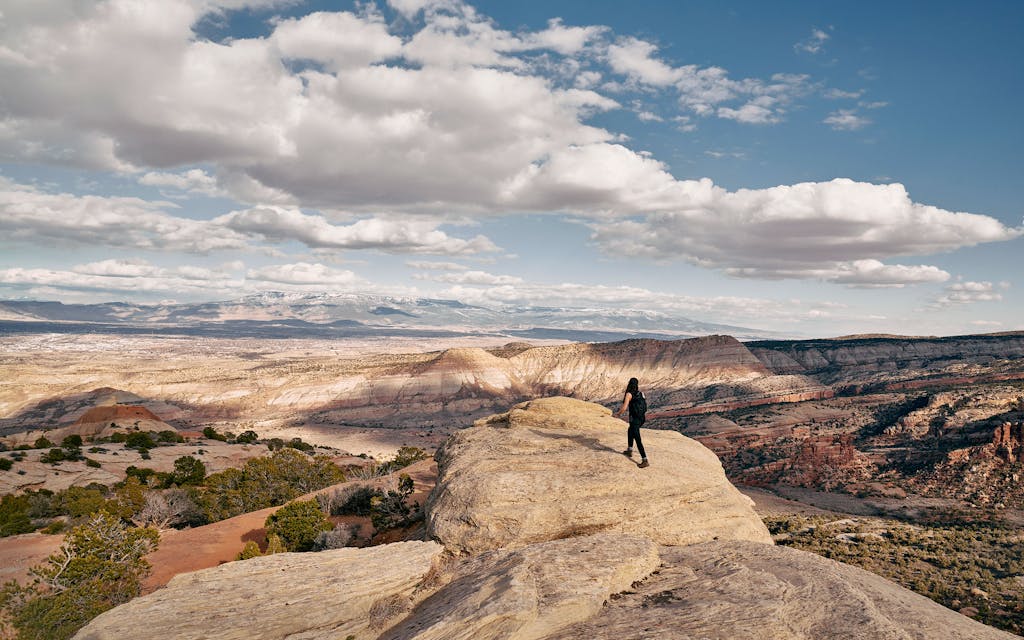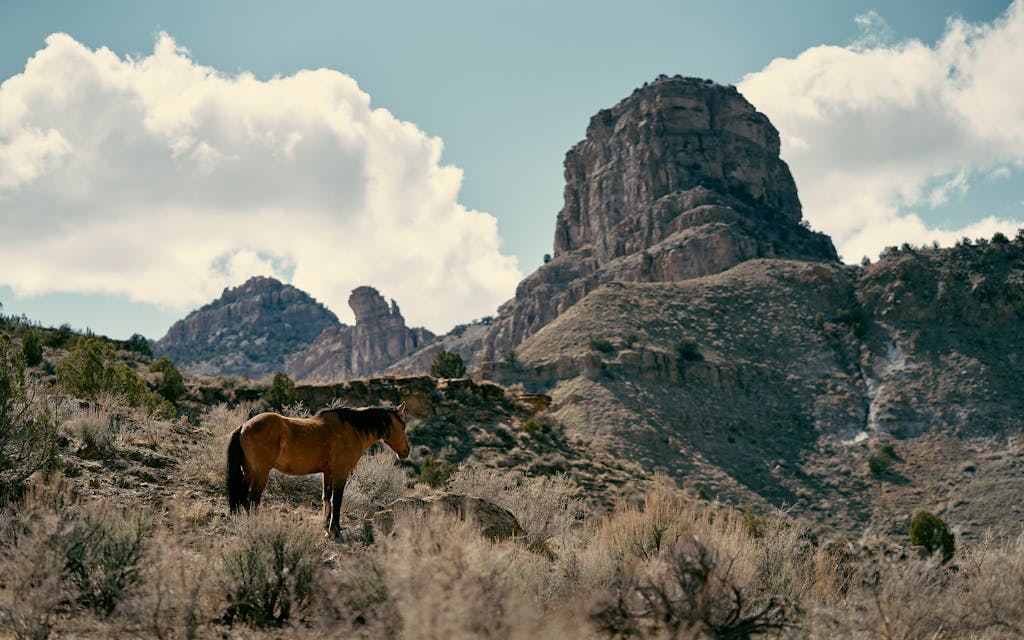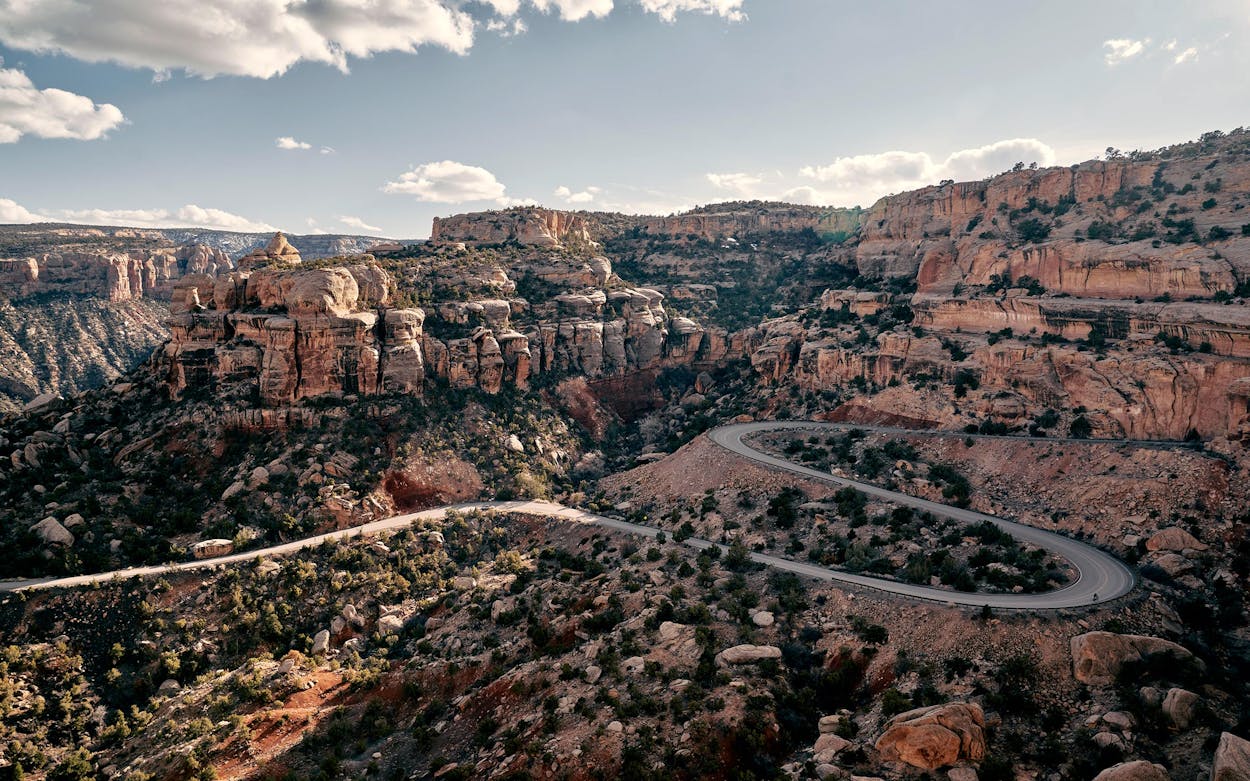As I emerged from an aspen-shaded stretch of the Cliff Creek Trail, in Colorado’s West Elk Mountains, I inhaled big gulps of cool air and reveled in the muscle burn from miles of steep hiking. A 360-degree view opened around me, and except for my husband, Chris, I didn’t see another soul on that July day in the middle of a pandemic year. I stopped, spun around a couple of times, and pretended I was in the opening scene of The Sound of Music.
Almost every summer, as Mother Nature fires up the annual blowtorch that turns Texas into a scorched expanse of burnt vegetation and wilted humans, I ditch my home state and head for the mountains of Colorado. Whether I’m gunning for vigorous exercise or just taking a break from screens and other people, outdoor adventures in this state give me the chance to focus on what brings me joy: the spicy smell of pine trees, awe-inducing geological formations, and the general grooviness of nature.
Hiking in the Rocky Mountains always leaves me gobsmacked, but never so much as last summer, when I traveled for the first time after months of isolating at home in Austin. Take that 11.4-mile Cliff Creek hike, for example. Those aspens I’d walked beneath weren’t really thousands of separate trees. They were part of one of the largest aspen groves in North America, a single clonal colony that sends up shoots from the same root system. I’d just tiptoed across the fingertips of one of the world’s largest living organisms, and the sheer audacity of that idea rattled around in my brain for days.

The trail cuts through the remote West Elk Wilderness, 176,412 acres located within Gunnison National Forest, in west Colorado. It’s part of a network of pathways that branch off Kebler Pass, a 33-mile dirt road, passable only in warm months, that links Crested Butte, to the east, with Paonia, to the west. The trails undulate up mountain flanks and curl around cold-water creeks. Chris and I slept in a rental from Native Campervans, in Denver, which we parked for free on nearby public land. (More than a third of the land in Colorado—roughly 24.1 million acres—is publicly owned, a sharp contrast to the 1.9 percent, or 3.2 million acres, of such land in Texas.)
Our weeklong trip included other spots removed from the beaten path. We parked our van for a night between rows of apple trees at Big B’s Fruit Company, an orchard and campground near Paonia. We also spent a day rafting the Arkansas River through Browns Canyon National Monument, near Salida, and we explored the lightly visited north rim of the Black Canyon of the Gunnison, where you can look straight down into a nearly 2,200-foot-deep gorge.
But for me, hiking has always been the biggest lure to Colorado, a satisfying, move-at-the-pace-of-nature way to see up close the geology and plant life of a much cooler (in degrees, that is) nearby state. Chris and I have spent weeks backpacking the John Muir Trail, in California, and crisscrossing Montana’s Glacier National Park on foot, but as with many other Texans, our go-to summer destination is Colorado. And while road-trippers often head to popular spots such as Denver and the Garden of the Gods, in Colorado Springs, I’ve always been drawn to farther-flung parts of the Centennial State where, even before the pandemic, it was easy to have a socially distant vacation.
One of my favorite destinations is the Colorado National Monument, a vast patch of high desert in the western part of the state, just outside Grand Junction, that ascends two thousand feet from the Grand Valley of the Colorado River. The 31-square-mile park, which gets overlooked in all the buzz surrounding Rocky Mountain National Park, is to me a cross between the Grand Canyon and Utah’s Arches National Park, with strange rock formations that look as if they were molded by a giant from one of those vintage Silly Sand kits. In the spring, you might see waterfalls spilling down rock faces that are typically bone-dry.
My last visit there coincided with driving rain and swirling fog, which foiled my plans to hike at least a few of the Monument’s seventeen trails, but the soggy weather gave the place a mystical, almost eerie vibe, with red, yellow, and brown pillars of rock drifting in and out of view. In my van, I navigated 23 miles of juniper- and piñon-lined switchbacks, looking for bighorn sheep and bald eagles.
Pit Stop!
Don’t miss the fry bread stuffed with Colorado bison at Tocabe, a fast-casual American Indian restaurant in north Denver. Most of the ingredients are sourced from Indigenous farmers. —José R. Ralat
A return trip to the Monument is high on my post-pandemic travel list. I’ll bring my mountain bike with me: a new 34-mile single-track bike trail called the Palisade Plunge, which drops six thousand feet from the top of Grand Mesa to the fruit-and-wine mecca of Palisade, on the valley floor, is scheduled to open this summer. I’ve already mapped out my itinerary. After I make it down the mountain, I’ll stop by the tasting room at Peach Street Distillers for a celebratory shot of its small-batch bourbon before collapsing in a bed at the Spoke and Vine, a motel built in 1955 that was refurbished a couple of years ago.
Also near Grand Junction is the 36,000-acre Little Book Cliffs Wild Horse Range, its terrain looking, for all the world, like Big Bend. I once embarked on a hike there in search of the free-roaming wild mustangs that have inhabited the area for centuries. After following a trail up a ridgeline for an hour and stepping over an orchard’s worth of horse apples, I finally saw four of the untamed beauties. Three females and a bossy stallion munched grass far below while I watched from a hill two hundred yards away in awe—yet another reward for exploring the state’s more remote regions.

Those who want more of a challenge—and a literal change of scenery—can hike from one mountain town to the next, as I did on a memorable trip to Crested Butte, which lies alongside the Maroon Bells pair of mountains, in central Colorado. I stuffed a change of shoes and a nice dress into a day pack and drove to the West Maroon trailhead, where Chris and I struck out on a glorious early September morning with a mission to hike eleven miles to the luxe resort town of Aspen. There, we would check into a hotel, grab a shower, and enjoy dinner and a night out before chugging back to Crested Butte the next day.
Day one served up blue skies and T-shirt temperatures as we made the gradual climb past fields of purple and orange wildflowers to the 12,500-foot pass, where we paused to admire the foothills spilling out around us. From there we descended 3,000 feet to Maroon Lake, where we caught a shuttle to Aspen. It’s a challenging hike, but if you’re relatively fit, you can make the trip in six hours—especially if you’ve got grilled lamb or venison waiting for you at the upscale restaurant Bosq and a room at the posh Limelight Hotel.
The return trip the next day reminded us of Mother Nature’s dark sense of humor. We checked the forecast and set out early, but a few hours in, a cold rain started. I yanked on a rain shell and gloves, but when the sleet hit, my skin dimpled like a plucked chicken. Then came the snow—big, wet flakes that quickly turned the trail up and over the pass into a Slip ’n Slide. I’ve rarely been so cold, but we managed to thaw out a few hours later while sipping hot chocolate in the lobby of the cozy Elk Mountain Lodge, back in Crested Butte. It was a vivid reminder that it’s possible to transition from summer to fall to winter in the span of two days in the Colorado mountains. And when it gets bitter cold, this Texas girl knows it’s time to head home. (Or go skiing. But that’s another story.)
Pam LeBlanc is an Austin-based travel and adventure writer.
This article originally appeared in the May 2021 issue of Texas Monthly with the headline “Hiking the Mountain Trails Less Traveled.” Subscribe today.







